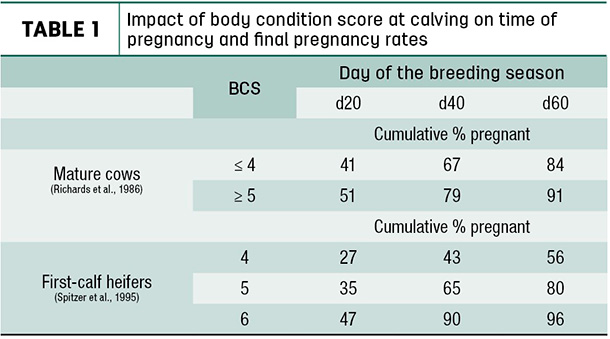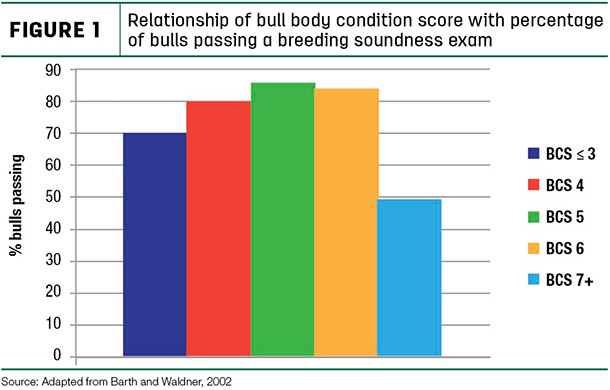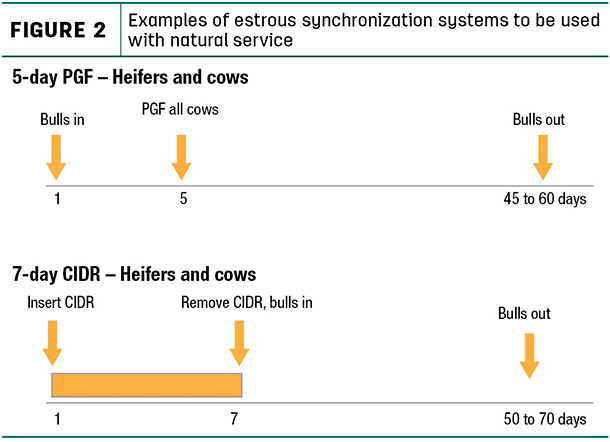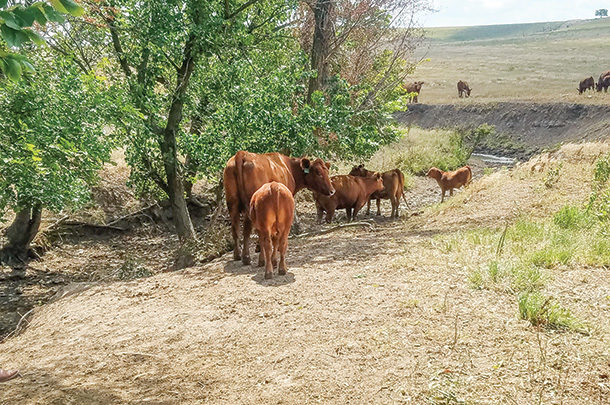The drought of 2021 hit Western beef operations particularly hard. Reports from the field indicate pregnancy rates last fall were 3% to 10% lower than normal with scattered reports of greater reductions in pregnancy rates. The Climate Prediction Center indicates drought will continue for most of the West and Northern Great Plains – although there may be some easing of drought in the Pacific Northwest.
The primary drought-related causes of reduction in pregnancy rates are heat stress and nutrition. Heat stress in cows and heifers results in greater early embryonic mortality, while the effects on bulls are reduced sperm quality and fertility. Poor nutrition in cows delays the return of estrous cycles after calving as well as reducing pregnancy rates in cycling cows. Bulls that are extremely nutritionally stressed have decreased fertility. So what are some strategies to reduce the reproductive effects of drought in 2022?
Get cows pregnant early
By getting cows pregnant early in the breeding season, the effects of heat stress for both cows and bulls are reduced. In addition, pregnancies are being established when forage quality is higher. Strategies include managing nutrition, reducing the effects of the calf and inducing estrous cycles.
Focusing on having cows in a proper body condition score (BCS) by calving will increase early season pregnancy rates (Table 1).

Similarly, having bulls in the proper body condition (BCS 4-6) by the start of the breeding season improves fertility (Figure 1).

Avoiding having bulls overconditioned (BCS 7+) is extremely critical in years with high temperatures.
First-calf heifers will respond well to additional high-quality feed between calving and breeding. Research from a multistate study found that heifers gaining 2 pounds per day between calving and breeding conceived earlier in the breeding season and maintained a 14% pregnancy rate advantage compared to heifers gaining only 1 pound per day.
Temporary calf removal (48 to 72 hours) about a week before the start of the breeding season may increase early pregnancy rates. The more drastic step of completely weaning calves immediately before the breeding season will result in excellent early and season-long pregnancy rates. However, the operation must be able to handle weaned 3- and 4-month-old calves.
Research from Montana demonstrated that exposing cows and first-calf heifers to bulls for 45 days before the breeding season will hasten estrous cycles by 20 days. “Teaser” bulls can be utilized for this purpose but should be surgically altered to avoid unintended breeding. Females can also be fenceline-exposed to intact bulls; however, fences must be good to prevent bulls from breeding cows too early.
One of the most effective methods for increasing the number of females conceiving early in the breeding season is estrous synchronization accompanied by either artificial insemination (A.I.) or natural service. Estrous synchronization systems that use a progestin – MGA or CIDR – can induce cycles in cows and heifers. Successful estrous synchronization programs can result in 70% to 80% of the females calving in the first 30 days. Estrous synchronization protocols for use with A.I. can be found at the Beef Reproduction Task Force site or in the back of A.I. stud catalogs.
Figure 2 illustrates two examples of synchronization systems for use with natural service.

Work from Kentucky demonstrated that estrous synchronization with natural service increases the percentage of cows conceiving early and improved overall pregnancy rates (Table 2).

Contact your extension professional for additional information on estrous synchronization and natural service.
Maintain pregnancies
Once conception has occurred, reducing nutritional, transportation and heat stresses should decrease the incidence of early embryonic mortality. Research from South Dakota found that if heifers were moved to range/pasture several weeks before A.I., they had greater pregnancy rates than heifers that were moved to pasture immediately after A.I. This appeared to be a result of the change in location and grazing behavior, which affected nutrition even though both groups of heifers were similarly supplemented.
Another study demonstrated that feeding dried distillers grains for 42 days after A.I. improved pregnancy rates on heifers moved from drylot to pasture compared to unsupplemented heifers. Researchers from Oregon and Texas found that feeding calcium salts of soybean oil to cows for 21 days after A.I. improved pregnancy rates. For more details on these studies, see the Progressive Cattle article from spring 2021 (Extra attention to nutrition during the breeding season will yield benefits).
Trucking cattle to pasture can increase early embryonic mortality. Studies from Colorado demonstrated that cows moved one to four days after A.I. had better pregnancy rates than cows trucked eight to 12 days or 29 to 33 days after A.I. It is not clear how herding or trailing cattle early in pregnancy may affect pregnancy rates to A.I. or natural service. However, to reduce the negative effects of heat stress on pregnancy, cattle should be trailed early in the morning if moved during the hot times of year.
Keep only cows that conceive early
If drought in 2022 results in the need for herd reductions, cows that will calve early should be the ones kept. Keeping early calving cows maintains a cow herd that is adapted to conditions of the ranch. In addition, it will result in heavier weaning weights due to calves being older at weaning.
One strategy would be to limit the breeding season to 45 to 60 days and retain only pregnant cows. Understandably, ranchers may not want to take the risk to pregnancy rates by making a drastic change to the length of the breeding season. Another strategy would be to pregnancy check the cows at 90 to 100 days after the start of the breeding season and retain cows that are pregnant at that time. Cows that became pregnant later could be marketed as bred cows or retained if drought conditions ease.
Enable cows to get pregnant in 2023
If drought continues into late summer of 2022, then strategies to enable cows to maintain body condition, make it through the winter and rebreed should be considered. These strategies would include:
- Early weaning calves at 150 days old
- Use of Conservation Reserve Program pastures
- Strategic supplementation of fall range
University of Idaho Extension specialists and educators produced videos discussing these options, which can be found online. Additional drought information can be found at UI Extension drought resources.
We all hope the drought eases and we can look forward to a better year in 2022. If not, it pays to be prepared.









